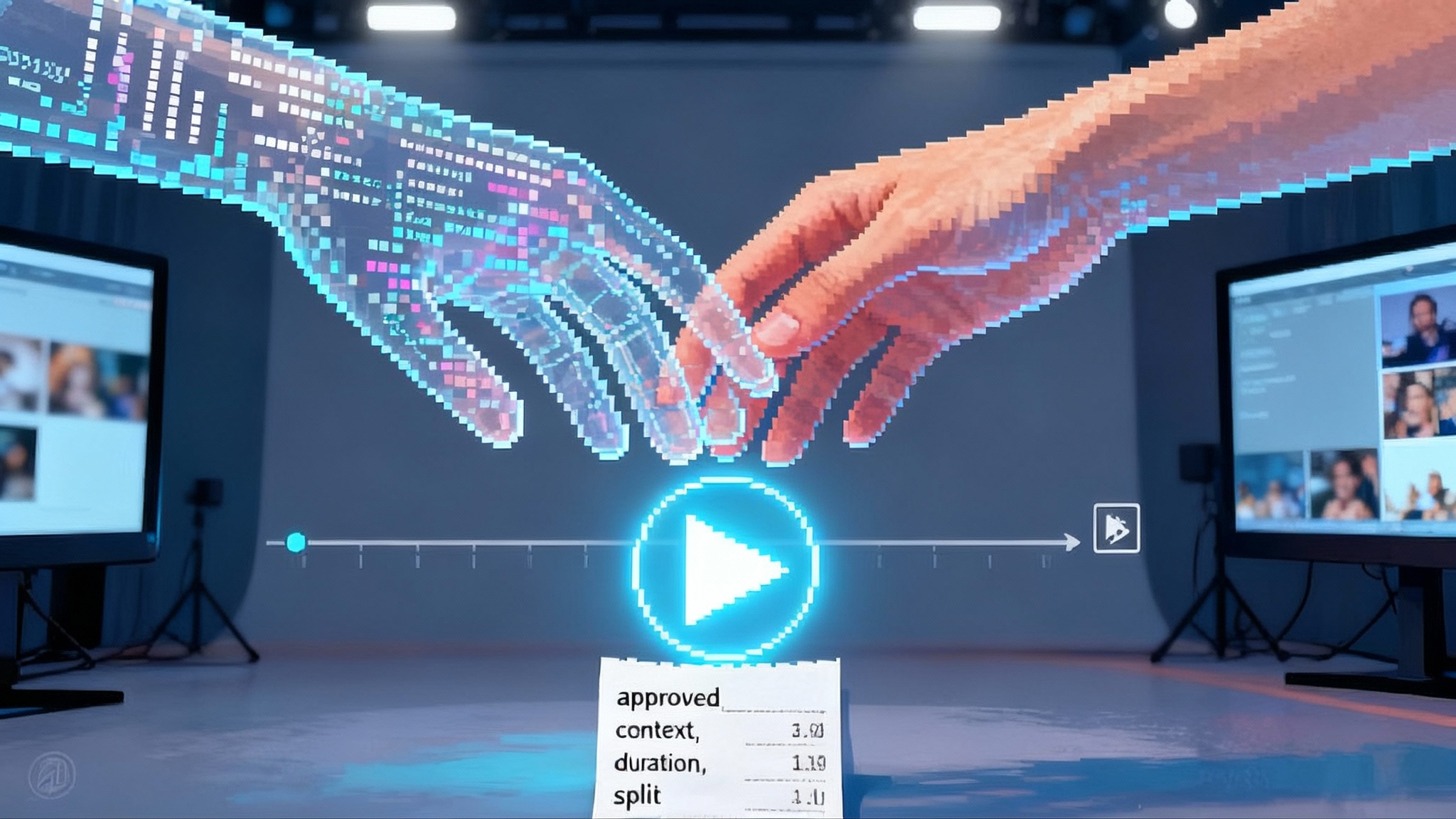Cognitive Accounting: AI Turns Memory Into Neural Capital
Enterprise AI is moving from chat to durable memory. This playbook shows how to inventory, measure, govern, and port neural capital with ledgers, receipts, portability standards, and audit-ready agents leaders can trust.

Breaking: Enterprise AI just became memory infrastructure
This month marks a real turning point for enterprise AI. Google introduced Gemini Enterprise as a unified front door for AI at work, consolidating agents, models, and enterprise controls in one place. The framing matters: it is not just a chatbot. It is a platform that connects company data, applications, and decision patterns so agents can perform real work. Read the official Gemini Enterprise announcement.
Microsoft’s October releases center on role-based Copilot agents across sales, service, and finance with multi-agent orchestration. Anthropic continues to push deeper into the enterprise with managed governance features and bundled coding agents. The combined signal is loud. Enterprise AI is hardening institutional memory and decision logic into a durable asset. The question now is not how to prompt better. It is how to measure, govern, and port this asset across vendors, years, and audits. In short, how to practice cognitive accounting.
Call it neural capital. It is the collection of model weights you tune, retrieval indexes you build, reasoning traces you log, playbooks your teams encode, and guardrails your legal group approves. Strip away logos and user interfaces and what remains is your firm’s cognition in machine-readable form.
If you are tracking broader platform shifts, this moment rhymes with our earlier view that assistants become native gateways. The difference now is that those gateways also preserve and compound memory.
From prompts to neural capital
For years many teams treated AI like a clever calculator that sometimes wrote love letters. Useful, yes. Disposable, also yes. In 2025 that view snapped into focus. Agent platforms now ingest your historical decisions, your process exceptions, your naming conventions, your supplier lore, and your quality thresholds. Over time, that corpus becomes specific enough to function as your company’s working memory.
A practical metaphor helps. Imagine your firm as a symphony orchestra. Musicians come and go. The sound endures because sheet music, annotations, and conductor markings persist. In AI terms, the score is your memory store and your agent’s decision policy. The first-chair violinist is your human expert in the loop. The conductor is your orchestration service that sequences tools and approvals. Neural capital is the library and the rehearsal tradition together, encoded so that new performers can play in time and in tune.
Why 2025 forces accounting for cognition
Two regulatory fronts are converging on the same idea. If models influence rights, money, or safety, organizations must know what the models know and where it came from.
- In the European Union, the Artificial Intelligence Act entered into force in 2024 with staggered application dates. Prohibitions and literacy obligations started February 2, 2025. Governance and obligations for general purpose AI models began August 2, 2025. Most high-risk rules and transparency obligations begin August 2, 2026, with additional product-embedded rules applying by 2027. The direction is clear. Companies will need documented transparency about data sources, performance, and limitations.
- In California, the California Privacy Protection Agency finalized regulations in September 2025 for automated decisionmaking technology, cybersecurity audits, and risk assessments. Requirements become effective January 1, 2026, with automated decisionmaking obligations beginning January 1, 2027 and staged audit attestations through 2030. See the agency’s finalized privacy and automated decisionmaking regulations.
These timelines mean your AI will need a paper trail. The trail will describe the model’s provenance, how it learned, how it reasons, and how its memory is curated. That is not a nice-to-have for compliance. It is the minimum viable accounting for cognition.
For a broader governance frame on how apps and agents merge into operating systems, revisit the conversational OS moment.
Assets and liabilities: translating AI into balance-sheet language
Executives do not need another abstract debate about whether AI is good or bad. They need a ledger that names what they are building, measures it in understandable units, and makes the tradeoffs visible.
- The asset: neural capital. Encoded know-how that causes faster cycle times, higher win rates, better customer resolution, or improved safety. This includes tuned weights, prompt and tool policies, vector indexes, task-specific agents, reasoning traces, and curated knowledge packs.
- The liabilities: audit, provenance, and retention. Audit means you can reproduce outcomes and explain why an agent acted as it did. Provenance means you can show where data and instructions came from and who approved them. Retention means you can keep or delete cognition in line with law and policy.
- The equity: trust with customers, regulators, and employees. Trust grows when you close the loop between decisions, evidence, and accountability.
This framing does not change Financial Accounting Standards Board rules overnight. It gives leaders a practical management accounting lens to steer investments while standards evolve.
The cognitive accounting model
You can operationalize neural capital with an internal accounting model that looks a lot like the way you manage software assets. Three layers keep the model concrete.
1) Memory inventory
- Knowledge packs: curated collections, such as playbooks for fraud review, underwriting rules for small business loans, or compliance checklists for labeling and claims in marketing.
- Retrieval indexes: embeddings, sparse indexes, and feature stores that make those packs findable by agents with explicit freshness and quality scores.
- Reasoning policies: task graphs, tool call rules, and escalation thresholds that define how agents think and when they hand off to humans.
2) Measurement
- Replacement cost: the time and spend required to rebuild memory or policy if you had to switch vendors or use a clean room.
- Contribution margin uplift: change in gross margin attributable to agents on a given process, such as faster collections or reduced write-offs.
- Risk-adjusted value: benefits net of expected loss from error, lag, or misuse, discounted for model drift.
3) Control
- Access classes: who can read, write, and execute memory and policies. Think least privilege for cognition.
- Testing gates: pre-deployment unit tests for prompts and tools, plus post-deployment monitors for hallucination rate, policy violations, and safety incidents.
- Chain of custody: signatures on memory updates, with reviewer identity, date, source, and justification.
Depreciation of cognition
Models and memory go stale. Vendors ship updates. Your business changes. That means neural capital needs a straight-line or usage-based amortization schedule like any other intangible. Establish triggers for impairment tests: a major vendor model upgrade that requires re-tuning, a regulatory change that invalidates a prompt policy, or an internal process change that obsoletes a knowledge pack. When a trigger hits, you mark down the asset’s carrying value and budget a refresh.
A practical technique is cohort accounting. Group prompts, indexes, and policies by quarter created. Track downstream outcomes by cohort. If performance decays faster for a cohort, you can triage refresh work to the highest value memory.
What the October launches really change
Three shifts stand out in the newest enterprise platforms.
- Agent factories over chat windows: Platforms now treat agents as first-class citizens with catalogs, policies, and life cycle gates. You can spin up research agents, coding agents, and domain-specific bots, then compose them under human oversight.
- Native audit trails: Reasoning summaries and tool-use logs are moving from experimental feature to default metadata. That gives compliance teams something solid to review.
- Secure connect to the business reality: Out-of-the-box connectors to ERP, CRM, and analytics systems let you ground agents in truth without copying data all over the place.
Together these reduce the cognitive tax of building a trustworthy memory. They also raise the bar. If you can build this memory in a few clicks, you can lose it in a few clicks if you choose the wrong portability strategy.
A forward-looking playbook for neural capital
You do not need a new department. You need a few clear artifacts and habits that make your firm’s cognition explicit, measurable, and moveable.
1) Build a memory ledger
Treat knowledge like inventory. For each memory object, record name, owner, purpose, sources, freshness, validations, dependencies, and access policy. Include a pointer to the agent tasks that consume it. Store this ledger in a system your data governance team already uses. Require a pull request for every change, with automated checks for policy violations.
2) Make portability the default
Put export clauses into your contracts. Require vendors to support export of tuned weights when legally and technically feasible, plus neutral formats for retrieval indexes and task graphs. Insist on clear mappings from proprietary agent settings to open schema when you migrate. Treat your prompts, policies, and indexes as configuration assets that must be rebuildable with a new vendor in weeks, not quarters.
3) Govern provenance with receipts
Every time an agent learns something new, it should leave a receipt. The receipt states what changed, where the evidence came from, and who approved the change. Receipts link back to original sources when allowed. For sensitive domains, use sample-based reviews where legal can spot check reasoning traces without exposing restricted data.
4) Embrace auditability as a feature
Choose platforms that surface reasoning summaries, tool calls, and uncertainty measures in an analyst-readable format. Set up scorecards for hallucination rate, policy violations, escalation effectiveness, and time to detection. Train reviewers on what a healthy reasoning trace looks like. Make audit artifacts part of the standard output of agents that touch regulated or high-impact processes. For a deeper look at how evaluation itself can shape behavior, see our take on when tests change models.
5) Budget thinking, not just tokens
Introduce thinking budgets for important tasks. A thinking budget specifies how much time or compute an agent may spend exploring alternatives before settling on an answer, and what evidence thresholds must be met to proceed without human approval. Thinking budgets bring consistency to reasoning quality and cost.
6) Align retention with risk
Map memory retention to legal and operational risk, not just storage limits. For example, keep underwriting policies and decisions as long as regulators may revisit them, but expire ephemeral routing hints quickly. Automate retention enforcement. A memory you cannot delete on schedule becomes a liability, not an asset.
7) Put humans in named roles
Designate a memory librarian who curates packs, a policy steward who owns escalation rules, and a red team that stress tests agent strategies. These roles are part time in smaller firms. The key is clear ownership so that cognition does not drift unmanaged.
Concrete example: a retailer’s neural capital sprint
Consider a retailer with hundreds of micro-processes that rely on tribal knowledge: markdown cadence, vendor haggling tactics, visual merchandising standards, and playbooks for weather-driven demand spikes. In a four-week sprint, the team:
- Captures top ten playbooks as knowledge packs and writes crisp success metrics.
- Builds a retrieval index for five years of merchandising calendars, promotion briefs, and exception logs.
- Encodes decision policies that let an agent propose markdown windows with confidence thresholds and auto-escalation to a merchant when uncertainty is high.
- Establishes a memory ledger with receipts for each knowledge change and weekly reviews.
- Measures uplift as cycle-time reduction and gross margin variance compared to last quarter.
With a modern platform, they get out-of-the-box audit trails and secure connectors into finance and inventory systems. By week four, they stop arguing about whether the agent is smart in the abstract and start asking whether neural capital is compounding. It is, because the agent learns from every exception and reuses that lesson across categories.
Compliance that accelerates, not slows, adoption
If compliance is set up correctly, it becomes a speed feature. California’s automated decisionmaking regulations require risk assessments and staged audit certifications. You can meet those requirements by letting your agents produce their own evidence as they work. A good pattern is to embed a regulator-facing view: a timeline of inputs, tools used, thresholds applied, human approvals, and outcomes, tied back to the memory ledger entries in effect at the time. When an auditor asks why an agent made a decision in March, you can replay the exact cognition with the right context.
In the European Union, transparency obligations arriving in 2026 will push teams to expose data provenance, performance boundaries, and human oversight practices. If your agents already leave receipts and your memory ledger is clean, those disclosures are a report, not a rescue mission.
What leaders should do next week
- Chief executive: appoint one accountable owner for neural capital. Give them a 90-day target to stand up a memory ledger and ship a first audit-ready agent in a high-leverage process.
- Chief financial officer: add a neural capital line to management accounts. Track replacement cost, contribution margin uplift, and risk-adjusted value by process. Review quarterly like any capital program.
- Chief information officer: set portability standards now. Document export formats and rebuild playbooks. Run a quarterly migration fire drill on a small agent to prove you can switch.
- Chief information security officer: extend data loss prevention and access control to cognition. Treat reasoning traces and memory indexes as sensitive data classes with their own policies.
- General counsel: codify retention rules for memory objects. Define when to keep, when to hash, and when to purge. Pre-agree a template reasoning trace and receipt format that meets your disclosure needs.
If you are thinking about how all of this plugs into the broader market structure of platforms and supply chains, compare with our thesis that assistants become native gateways and how governance turns into product decisions in the conversational OS moment.
Market implications: neural capital on the deal table
In mergers and acquisitions, expect buyers to ask for a data room of cognition. That means escrow for tuned weights when feasible, export of retrieval indexes, copies of reasoning policies, and the memory ledger with receipts. Representations and warranties will expand to cover provenance of training data, absence of prohibited sources, and compliance with transparency rules in force on specific dates. Valuations will reward firms that can port cognition without a hard reset.
The road from prompt hacks to corporate cognition
The big platforms have given enterprises the missing ingredients: agent catalogs, native audit trails, and secure grounding in real business systems. Regulators have given the incentive to treat model-embedded know-how like any other high-impact asset. What remains is a managerial choice. Firms that operationalize memory with ledgers, receipts, portability standards, and thinking budgets will move faster because they are not guessing what the machine learned yesterday.
Neural capital is not an idea for a whiteboard. It is the name for something you already own, often scattered and fragile. Gather it. Measure it. Govern it. Make it move with you when vendors change. The companies that master this new accounting will compound their cognition faster than rivals, and the compounding will show up where it matters most: in decisions that are better, sooner, and safer.








